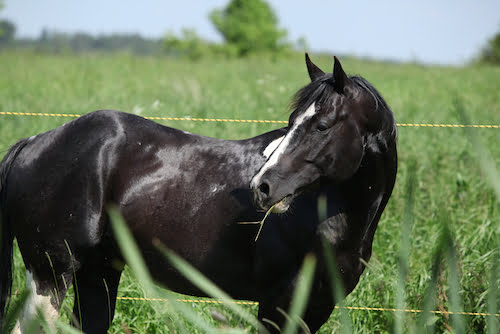
[dropcap]A[/dropcap] horse is croup high when his hindquarters are higher than his wither. Some breeds are built that way because of the work that they do, such as some Quarter Horse strains for some of the Western classes and many Thoroughbreds now stand croup high because of the way that they have been bred.
A very croup high horse will find it more difficult to engage by lowering his croup and often feels as though he is more powerful behind than he is in front. A croup high horse is built on the forehand, which puts extra weight on his front legs as well as adding to possible wear and tear to the front legs. Croup high horses can also ride heavy in the rider’s hands because of their downhill build.
Ways to improve
You can’t change the conformation fault but you can improve their way of going with time, effort and patience. Just because your horse is croup high, it doesn’t mean that he isn’t talented. There are exercises that you can do to help him use his hindquarter to the best of his ability.
Always take care when you start working on a pony’s weak points. Overdoing it can hurt and strain muscles and ligaments. Be patient and get advice from knowledgeable riders and trainers.
Training exercises
Rhythm is always key in any riding. For the croup high horse it is very important as you teach him to use his body more correctly.
Transitions
Transitions while riding in rhythm are very helpful. Ridden correctly your horse will start to engage more with each transition. You can ride transitions within a pace (for example, working trot to lengthened trot or collected trot) or transitions into and out of a pace (for example, canter-trot-canter transitions).

Pole work and cavalettis
Using poles on the ground and cavalettis to work over helps your horse to work in a rhythm. They can help him lengthen or shorten and in gymnastic exercises can help him learn how to tuck his pelvis more.
Shoulder in and lateral work
Any exercise which works on suppleness is important. They must be introduced gradually though to avoid over-stressing the hind legs and injuring tendons, ligaments or muscles.
Big and small circles
When your horse is a bit stronger and better balanced, you can start to incorporate smaller circles. Don’t focus on them for too long, however, as they are hard work for the back legs.
While you are working on these exercises make sure that your horse stays relaxed and well connected so that he uses his back in the best way possible. You will notice as his suppleness and strength improve that you will have a better rein contact, better balance and a much nicer ride.
Text: Mandy Schroder

